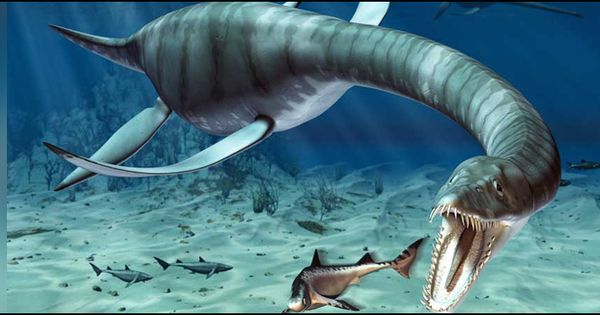The fossilized remnants of a second massive jawbone measuring more than two meters long were discovered on a beach in Somerset, UK. Experts have recognized the bones as the jaws of a new species of massive ichthyosaur, a type of prehistoric sea reptile. According to estimates, the marine giant would have been longer than 25 meters.
Justin and Ruby Reynolds, a father and daughter from Braunton, Devon, discovered the first bits of the second jawbone in May 2020 while searching for fossils on the beach at Blue Anchor, Somerset. Ruby, then 11, discovered the first bit of gigantic bone before the group searched for others.
When they realized they had unearthed something substantial, they contacted Dr. Dean Lomax, a paleontologist at The University of Manchester and a famous ichthyosaur expert. Dr. Lomax, who is also an 1851 Research Fellow at the University of Bristol, contacted Paul de la Salle, a seasoned fossil collector who discovered the first enormous jawbone in May 2016 from further along the coast at Lilstock.
Dr Dean Lomax said: “I was amazed by the find. In 2018, my team (including Paul de la Salle) studied and described Paul’s giant jawbone and we had hoped that one day another would come to light. This new specimen is more complete, better preserved, and shows that we now have two of these giant bones — called a surangular — that have a unique shape and structure. I became very excited, to say the least.”
This research has been ongoing for about eight years. It’s incredible to believe that giant, blue whale-sized ichthyosaurs were swimming in the oceans surrounding what was formerly the United Kingdom during the Triassic Period.
Dr. Lomax
Justin and Ruby, along with Paul, Dr. Lomax, and numerous family members, went to the site to look for further fragments of this unique discovery. Over time, the scientists discovered more parts of the same jaw that fit flawlessly together, like a multimillion-year-old jigsaw.
Justin stated, “When Ruby and I discovered the first two pieces, we were quite delighted because we realized this was something important and uncommon. When I discovered the back section of the jaw, I was overjoyed because it was one of the distinguishing features of Paul’s previous discovery.”
The research team, led by Dr Lomax, revealed that the jaw bones belong to a new species of giant ichthyosaur that would have been about the size of a blue whale. Comparing the two examples of the same bone with the same unique features from the same geologic time zone supports their identifications.
The team have called the new genus and species Ichthyotitan severnensis, meaning “giant fish lizard of the Severn.”

The bones are around 202 million years old and are from the conclusion of the Triassic Period, sometimes known as the Rhaetian. During this time, giant ichthyosaurs swam the oceans and dinosaurs walked on land. The giants’ final chapter, however, is recorded in the strata above these fossils, which depict a calamity known as the Late Triassic global mass extinction event. After this time, huge ichthyosaurs from the Shastasauridae family become extinct. Today, these bones are the last of their kind.
Ichthyotitan is not the world’s first giant ichthyosaur, but de la Salles’ and Reynolds’ discoveries are unique among those known to science. These two bones appear roughly 13 million years after their latest geologic relatives, including Shonisaurus sikanniensis from British Columbia, Canada, and Himalayasaurus tibetensis from Tibet, China.
Dr Lomax added: “I was highly impressed that Ruby and Justin correctly identified the discovery as another enormous jawbone from an ichthyosaur. They recognised that it matched the one we described in 2018. I asked them whether they would like to join my team to study and describe this fossil, including naming it. They jumped at the chance. For Ruby, especially, she is now a published scientist who not only found but also helped to name a type of gigantic prehistoric reptile. There are probably not many 15-year-olds who can say that! A Mary Anning in the making, perhaps.”
Ruby said: “It was so cool to discover part of this gigantic ichthyosaur. I am very proud to have played a part in a scientific discovery like this.”
Further examinations of the bones’ internal structures have been carried out by master’s student, Marcello Perillo, from the University of Bonn, Germany. His work confirmed the ichthyosaur origin of the bones and revealed that the animal was still growing at the time of death.
He stated, “We could confirm the unique set of histological characters typical of giant ichthyosaur lower jaws: the anomalous periosteal growth of these bones hints at yet-to-be-understood bone developmental strategies, now lost in the depths of time, that likely allowed late Triassic ichthyosaurs to reach the known biological limits of vertebrates in terms of size. So much about these giants remains unknown, but one fossil at a time, we will be able to uncover their secrets.”
Concluding the work, Paul de la Salle added: “To think that my discovery in 2016 would spark so much interest in these enormous creatures fills me with joy. When I found the first jawbone, I knew it was something special. To have a second that confirms our findings is incredible. I am overjoyed.”
The new findings were published today in the open-access journal PLOS ONE. Ruby, Justin, and Paul’s finds will shortly be on display at the Bristol Museum and Art Gallery.
Lomax stated, “This research has been ongoing for about eight years. It’s incredible to believe that giant, blue whale-sized ichthyosaurs were swimming in the oceans surrounding what was formerly the United Kingdom during the Triassic Period. These jawbones offer tantalising clues that one of these giants’ full skulls or skeletons may be discovered one day. “You never know.”
















